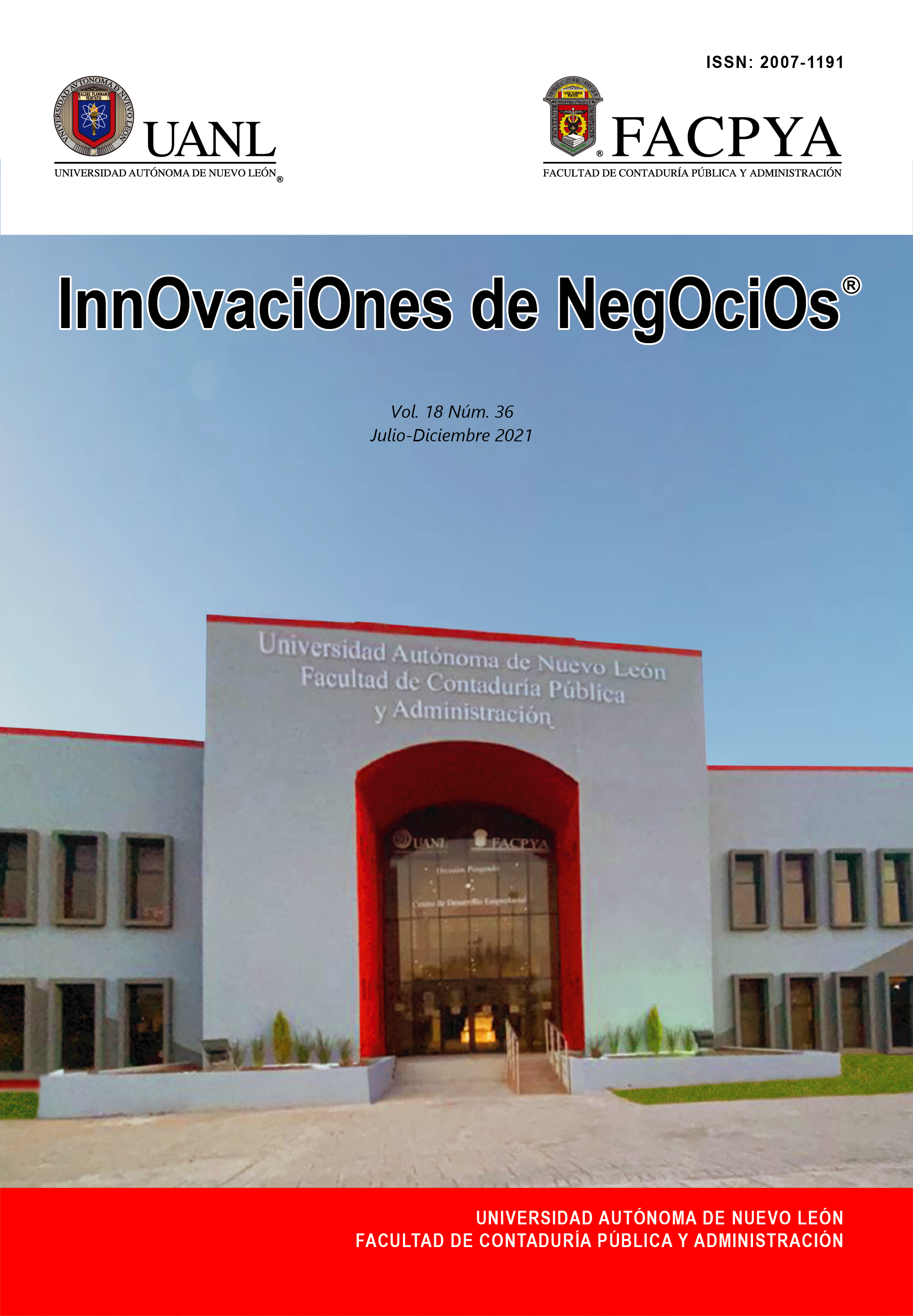Design, validity, and reliability of an evaluation instrument to measure the causal factors of Burnout Syndrome and engagement mediation
DOI:
https://doi.org/10.29105/rinn18.36-1Keywords:
Burnout, engagement, health professionals, organizational factors, quality of lifeAbstract
Burnout Syndrome (BS) is a result of chronic work stress, which generates physical, psychological, and organizational consequences. Several studies have shown the danger that health professionals run from being victims of BS, therefore, the importance of evaluating health organizations. The objective of this study was to determine the validity and reliability of an evaluation instrument that measures the causal factors of Burnout Syndrome and the mediation of engagement.
Cross-sectional study developed in health professionals. Carried out in two stages, the first stage consisted of content validity by experts from the area of Human Capital and the second stage was the evaluation of the reliability of the
instrument through the statistical method of Cronbach's Alpha. The results showed that this tool is valid and reliable to be applied on a larger scale, since the statistical values of Cronbach's Alpha were higher than 0.7 and all the experts
approved the scale. It was concluded that any data collection method must meet the validity and reliability requirements before proceeding with the sample collection.
Downloads
References
Akbari, M. y Morteza, S. (2018). The Relationship of Spiritual Health and Quality of Life, Mental Health, and Burnout: The Mediating Role of Emotional Regulation. Iran J Psychiatry, 13(1), 22-31.
Ashrafi, Z., Ebrahimi, H., Khosravi, A., Navidian, A. y Ghajar, A. (2018). The relationship between quality of work-life and burnout: a linear regression structural-equation modeling. Health Scope, 7(1), 1-7.
Berjón, M. A., Urquijo, M., & Pérez, J. (2018). La mujer en actividades de asistencia a personas mayores. Exposición a factores psicosociales. Seguridad y Salud en el Trabajo(97), 40-43.
Cámara de Diputados del H. Congreso de la Unión. (2019). Ley Federal del Trabajo. México: Secretaria General.
Contreras, A. y Gómez, A. (2018). Aplicación de los Cuestionarios de Denison para determinar las características de la Cultura Organizacional. Revista de Investigación Sigma, 5(1), 59-86.
Cronbach, L. (1951). Coefficient alpha and the internal structure of tests. Psychometrika, 16(3), 297-334.
Denison, D. y Mishra, A. (1995). Toward a Theory of Organizational Culture and Effectiveness. Organization Science, 6(2), 204-224.
Domínguez-Lara, S. (2016). Secretos del coeficiente alfa. Actas Urológicas Españolas, 40(7), 471-471.
Fonseca, M., Sanclemente, G., Hernández, C., Visiedo, C., Bragulat, E. y Miró, Ó. (2010). Residentes, guardias y síndrome de burnout. Revista Clínica Española, 210(5), 209-215.
Freudenberger, H. (1974). Staff Burn-Out. Journal of Social Issues, 1, 159-165.
García-Sierra, R., Fernández-Castro, J., & Martínez-Zaragoza, F. (2016). Relationship between job demand and burnout in nurses: does it depend on work engagement? Journal of Nursing Management, 24(6), 780-788.
Ghorbanian, A., Naghdi, B., Jafari, H., & Sadeghi, A. (2018). The effect of organizational culture and individual motivation resources on staff burnout: a structural equation modeling approach. Evidence-Based Health Policy, Management & Economics, 2(3), 181-191.
Giorgi, G., Mancuso, S., Fiz, F., Castiello, A., Mucci, N., Cupelli, V. y Arcangeli, G. (2016). Bullying among nurses and its relationship with burnout and organizational climate. International Journal of Nursing Practice, 22(2), 160-168.
Giraldo, J. (1967). Jornada de Trabajo. Revista Facultad de Derecho y Ciencias Políticas, 41(43), 56-77.
Griethuijsen, R., Eijck, M., Haste, H., Brok, P., Skinner, N. y Mansour, N. (2014). Global patterns in students' views of science and interest in science. Research in Science Education, 45(4), 581-603.
Landa-Ramírez, E., Rangel-Dominguez, N., Villavicencio-Carranza, M., Weinger-Mehl, S., Reyes-Saavedra, M., González-Álvarez, R. y Jiménez-Escobar, I. (2017). Clima Organizacional y factores relacionados con el burnout en urgencias médicas: un estudio correlacional. Psicología y Salud, 27(2), 245-254.
Maslach, C. (1976). Burn-Out: the loss of human caring. Human Behavior, 5(9), 16-22.
Maslach, C. y Jackson, S. (1981). The measurement of experienced burnout. Journal of Occupational Behavior, 2(1), 99-113.
Mendoza, J. y Garza, J. (2009). La medición en el proceso de investigación científica: Evaluación de validez de contenido y confiabilidad. Innovaciones de Negocios, 6(1), 17-32.
Ministerio de Salud. (1998). Gestion de Servicios de Salud. Cajamarca: APRISABAC.
OIT. (2016). Organización Internacional del Trabajo.
OMS. (1996). ¿Qué calidad de vida? Foro Mundial de la Salud, 17(4), 385-387.
Prieto-Miranda, S., Jiménez-Bernardino, C., Cázares-Ramírez, G., Vera-Haro, M., y Esparza-Pérez, R. (2015). Jornadas laborales y sus repercusiones en médicos residentes en un hospital de segundo nivel. Med Int Mex, 31(6), 669-679.
Quinn, R. y Rohrbaugh, J. (1983). A Spatial Model of Effectiveness Criteria: Towards a Competing Values Approach to Organizational Analysis. Management Science, 29(3), 363-377.
Rositas, J. (2014). Los tamaños de las muestras en encuestas de las ciencias sociales y su repercución en la generación del conocimiento. InnOvaciones de Negocias, 11(22), 235-268.
Salanova, M., Shaufeli, W., Llorens, S., Peiro, J. y Grau, R. (2000). Desde el "burnout" al "engagement", ¿una nueva perspectiva? Revista de Psicología del Trabajo y de las Organizaciones, 16(2), 117-134.
Segredo, A. (2017). Instrumento para la evaluación del clima organizacional en salud. Revista Cubana de Salud Pública, 43(1), 57-67.
Vidotti, V., Trevisan, J., Quina, M., Perfeito, R. y Carmo, M. (2019). Síndrome de burnout, estrés laboral y calidad de vida en trabajadores de enfermería. Enfermería Global, 18(3), 344-354.
Published
How to Cite
Issue
Section
License
Copyright (c) 2021 Innovaciones de Negocios

This work is licensed under a Creative Commons Attribution-NonCommercial-ShareAlike 4.0 International License.
The InnOvaciOnes de NegOciOs magazine is a free and open access electronic magazine of a scientific-academic nature and is a publication of the Autonomous University of Nuevo León, in which the authors retain their copyright and grant the magazine the exclusive right to first publication of the work. Third parties are allowed to use the published content, as long as the authorship of the work is acknowledged and the first publication in this journal is cited.
For more information, please contact the Research Secretary (FACPyA) of the Autonomous University of Nuevo León. Telephone: (81) 1340-4430. Email: revinnova@uanl.mx










